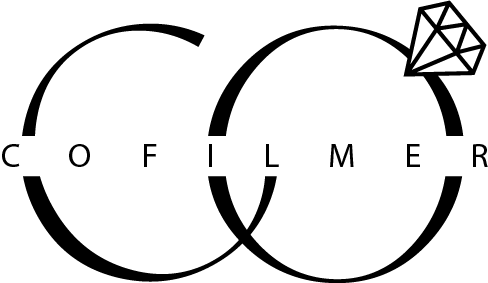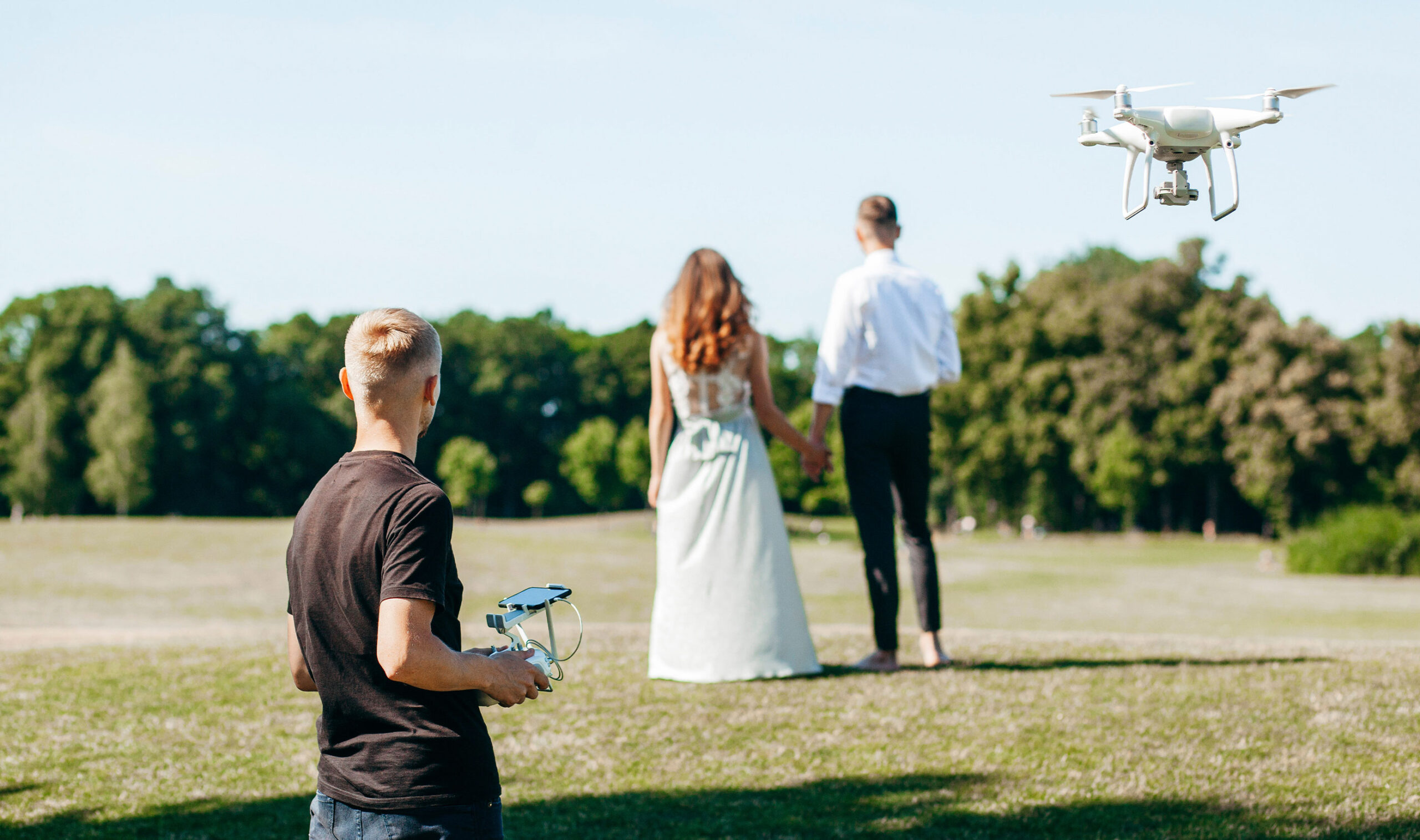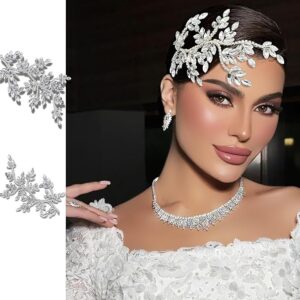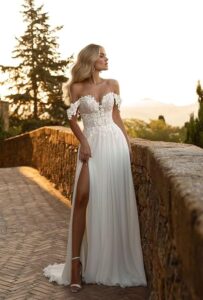What are some of the benefits of using a drone for wedding photography?
Using a drone for wedding photography can offer a number of benefits, including:
- Unique and expansive aerial views: Drones can capture unique and expansive aerial views of the wedding location, which can add a sense of grandeur and drama to the photographs.
- More creative and artistic images: Drone photography allows photographers to capture images from unique angles and perspectives, which can add a creative and artistic element to the photographs.
- A new way to capture the whole event: Drones can provide a new way to capture the whole event and provide a different perspective on the celebration that may not be possible with traditional photography.
- Ability to create cinematic wedding film: Drone footage can be used to create cinematic wedding film, which can be an unique and memorable keepsake of your special day.
- High-quality images: Drones are equipped with advanced cameras and imaging technologies, which can produce high-quality images that are crisp and clear.
- More efficient way of capturing images: Drone photography can be a more efficient way of capturing images, as the drone can cover a large area quickly and can be easily moved around.
- Enhancing landscape and background: Drones can provide a wider frame of the landscape and background of the event, which can enhance the setting and make the images more interesting.
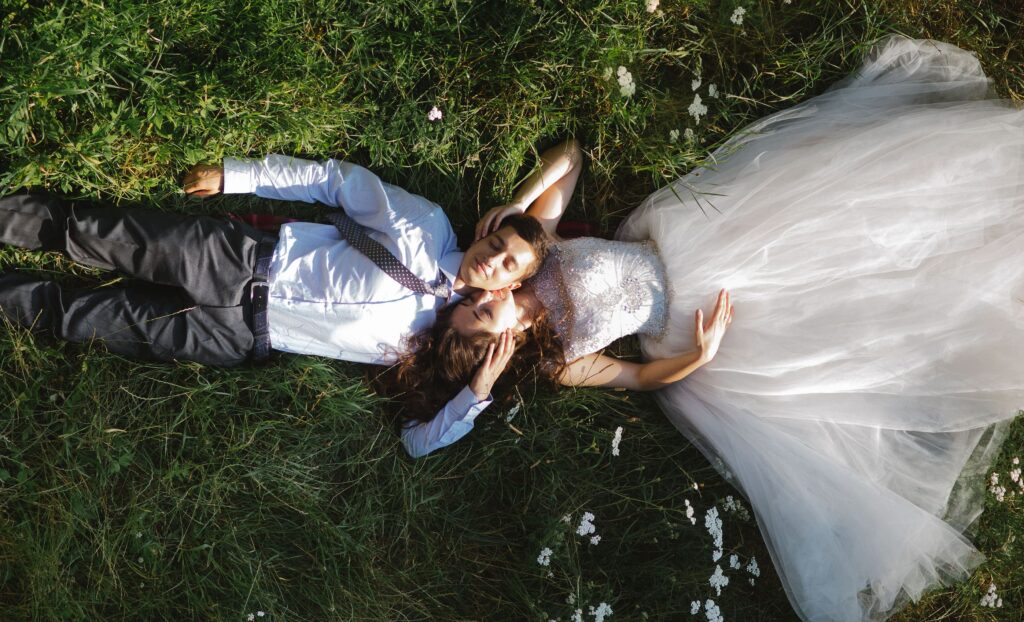
How do drones help to capture unique and expansive aerial views of the wedding location?
Drones are equipped with advanced cameras and imaging technologies, which allow them to capture unique and expansive aerial views of the wedding location. The drones are able to fly at high altitudes and capture images from a wide range of angles and perspectives. This can provide a new and unique perspective on the wedding location that may not be possible with traditional photography.
For example, drones can capture sweeping aerial views of the ceremony location, the reception venue, and the surrounding landscape. They can also capture images of the wedding party and guests from above, which can create a sense of grandeur and drama in the photographs.
How can couples choose the right drone and photographer for their wedding photography?
Choosing the right drone and photographer for your wedding photography can be a daunting task, but there are a few things you can do to make the process a little easier. Here are a few tips to help you make your decision:
- Research different drone and photography companies. Look at their portfolios and read reviews from past clients. This will give you an idea of the quality of their work and their level of experience.
- Determine your budget. Wedding photography and drone services can vary greatly in price, so it’s important to determine how much you’re willing to spend before you start looking.
- Look for a drone pilot with a Remote Pilot Certification, issued by the FAA, specifically for flying commercially.
- Schedule a meeting or call with potential photographers and drone pilots to discuss your specific needs and vision for your wedding photography. Ask questions about their experience, equipment, and availability on your wedding date.
- Consider your wedding location. Some venues may have restrictions on drone flights, so it’s important to choose a photographer and drone pilot who are familiar with the area and the rules.
- Lastly, ask for references and if possible check them, speak with the previous clients, ask about their experience, whether they recommend that particular drone/photographer for their wedding or not.
By following these tips, you should be able to find a drone and photographer that will help you capture beautiful and unique wedding memories.
What are some of the legal considerations for using a drone at a wedding?
When using a drone at a wedding, there are several legal considerations that must be taken into account. Here are a few things to keep in mind:
- FAA regulations: All drone flights must be conducted in compliance with Federal Aviation Administration (FAA) regulations. This includes flying below 400 feet, maintaining visual line-of-sight with the drone, and not flying near airports or other restricted airspace. The drone pilot also must have Remote Pilot Certification and also must have a Special Airworthiness certificate for a particular aircraft, this is important and it’s a must to check before engaging a drone pilot.
- Privacy considerations: Drones equipped with cameras can raise privacy concerns, especially if they’re flown over private property or in areas where people have a reasonable expectation of privacy. As a drone operator, it’s important to be mindful of these considerations and obtain consent from anyone who may be impacted by the drone flight.
- Insurance: Drone operators should have liability insurance in case of any accidents or damage caused by the drone. This will help protect the operator, the client, and any third parties that may be affected by the drone flight.
- Event site restriction and clearance: Its important to check if the event location or venue has restriction on drones, or if any clearance is needed for flying drones. Some event venues might have total restriction, some might allow under certain condition, so its important to check with the venue before the event day.
- Obtaining permission to fly over private property: If you’re planning to fly a drone over private property that doesn’t belong to you, you’ll need to obtain permission from the property owner.
How can couples use drone footage to create a unique and cinematic wedding film?
Drone footage can be used to create unique and cinematic wedding films by adding a new dimension and perspective to the video. Here are a few ways couples can use drone footage to enhance their wedding film:
- Aerial shots of the venue: Drone footage can be used to capture aerial shots of the venue, including the ceremony and reception areas. These shots can provide a unique perspective and showcase the beauty of the location.
- Establishing shots: Drone footage can be used to capture establishing shots of the area surrounding the venue, including scenic views of the countryside, beaches, or cityscapes. These shots can set the scene and create a sense of place.
- Tracking shots: Drone footage can be used to capture tracking shots of the bride and groom as they move through the venue, such as during the processional or recessional. These shots can add movement and excitement to the film.
- Aerial panoramas: Drones are perfect for capturing panoramic shots, this can help to provide an overall image of the whole venue, giving a sense of the grandeur of the place.
- Creative shots: Drone footage can also be used to capture more creative and abstract shots, such as a shot from above of the bride and groom’s shadow on the ground or a shot of the wedding guests from high above.
- Timelapse: Drone footage can be used to capture timelapse of sunset or a busy city or any other place, this can be a great addition to the film and provide a unique perspective.
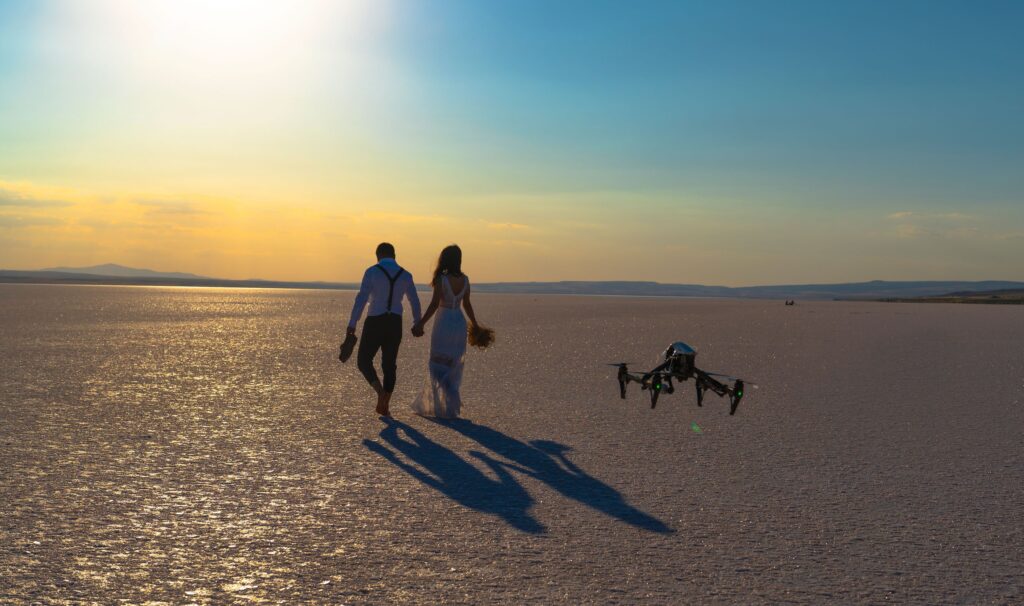
What are some of the challenges of using a drone for wedding photography?
While using a drone for wedding photography can provide many benefits, there are also several challenges that must be overcome. Here are a few of the main challenges of using a drone for wedding photography:
- Weather: Drone flights can be impacted by weather conditions such as high winds, rain, and snow. It is important for drone pilots to constantly monitor weather conditions, and to make sure that flights are conducted in safe weather conditions.
- Battery life: Drones rely on battery power to operate, and the battery life of most drones is limited. This can be a challenge when trying to capture extended footage of a wedding, so it’s important to have extra batteries on hand and to plan the flight schedule accordingly.
- Noise: Drones can be quite loud, and this can be a distraction during a wedding ceremony or reception. It’s important to choose a drone that’s quiet, or that can be operated in a “quiet” mode to minimize the noise impact.
- Complexity: Some drones can be very complex to operate, requiring a significant amount of skill and experience. It’s important to choose a drone operator who has experience and knowledge about how to operate the drone, and can troubleshoot problems if they arise.
- FAA Restrictions: Drone flights must be conducted in compliance with FAA regulations, and there are some areas which are restricted, also, drone pilots are required to have certifications, and these certifications are subject to renewal and follow-up checks. It’s important for drone operators to be familiar with FAA regulations, and to obtain any necessary approvals or permits before the wedding.
- Privacy: Drones can capture images of individuals without their knowledge or consent, this can be an issue and it’s important to be respectful of people’s privacy and to obtain consent before capturing images of people.
How does drone photography differ from traditional wedding photography?
Drone photography and traditional wedding photography are both ways to capture memories of a couple’s special day, but there are several key differences between the two. Here are a few ways in which drone photography differs from traditional wedding photography:
- Perspective: One of the main differences between drone photography and traditional wedding photography is the perspective from which the images are captured. Drone photography offers a unique bird’s-eye view that traditional wedding photography cannot replicate. This can be used to capture stunning aerial shots of the venue and landscapes, which can provide a unique perspective on the wedding day.
- Creativity: Drone photography opens up new creative possibilities for wedding photography. The unique perspective and camera angles of a drone can be used to capture creative and abstract shots that would be difficult or impossible to capture with traditional photography methods.
- Mobility: Traditional wedding photography is limited by the mobility of the photographer, while drones can fly and capture images from a wide range of angles, heights and locations that would be difficult or impossible to reach with traditional photography.
- Speed: Drones can move quickly and easily, which means that a drone operator can capture a wide variety of images in a short amount of time. This can be especially useful for capturing fast-moving action, like a bride and groom running through a field, or guests dancing at the reception.
- Cost: Drone photography can be a more expensive option than traditional wedding photography, as drones require specialized equipment and operators. Also, the FAA regulations and the required certification for the drone pilots can add additional cost to the service.
- Weather and lighting conditions: Drone photography is weather dependent and certain weather conditions such as high winds, rain and heavy clouds might prohibit or limit the flights. Also, drones might have difficulties capturing images in low light conditions.
